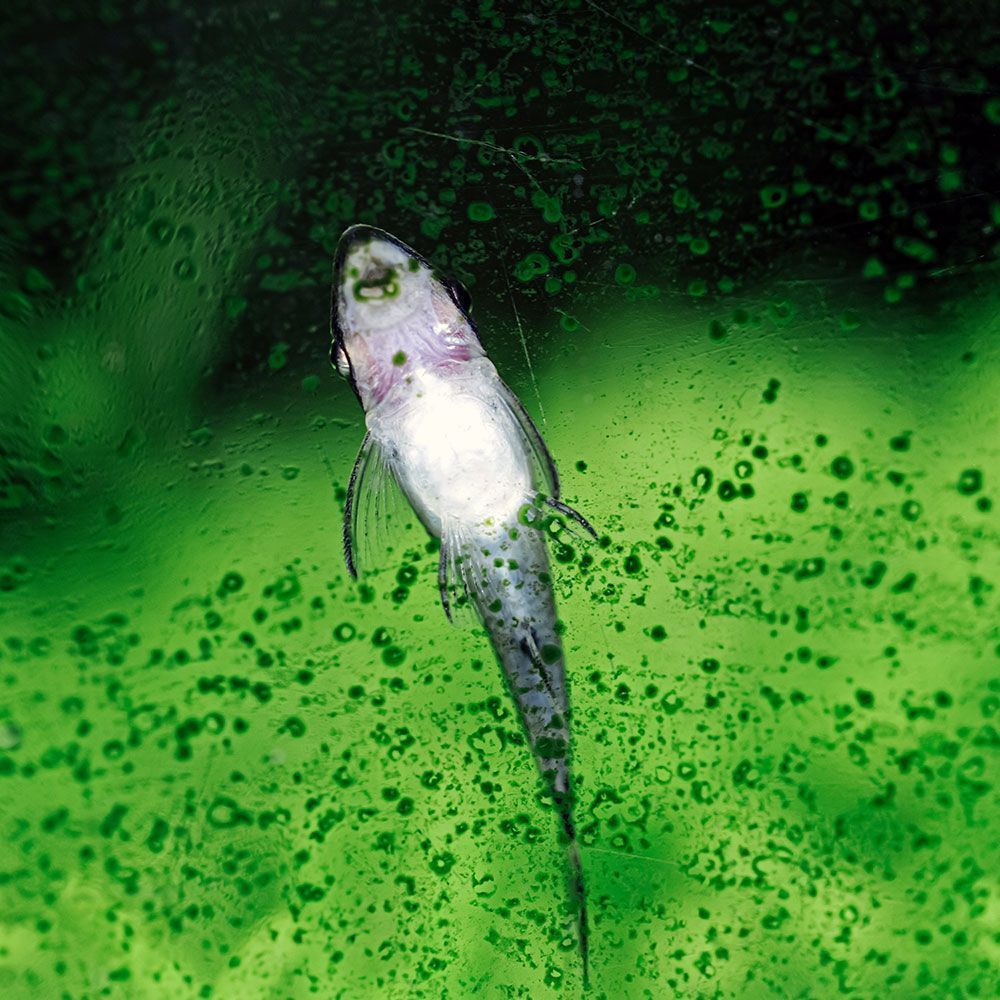Tank algae must be cleaned ASAP as it can negatively affect water quality. Learn about 25 algae types, causes & removal process for freshwater & marine tanks.
Do you know that algae forms the base of aquatic food resources? In fact, a diet of less than 10% algae boosts your fish’s growth.
However, that doesn’t imply that letting algae overtake your aquarium is okay. In fact, a visible amount of algae in such an enclosed space may actually be detrimental to your fish and other aquatic inhabitants’ lives.
So, to protect your precious aquatic friends’ home, let’s learn everything necessary here…
How to Get Rid of Algae in Fish Tank?
Some common ways to deal with any algae infestation are to manually remove them, use algae-eating cleanup crews, adjust the level of nutrients and light, clean rotting matter, and treat with algae-inhibiting chemicals.
But to treat each kind of algae, you need specific action steps. So, let’s get into the details here…
How to get Rid of Freshwater Algae?
If you have a freshwater aquarium, there are higher chances of it having the following kinds of algae. So, let’s know how to identify, eliminate, and prevent them.
1. Green Spot Algae (GSA)
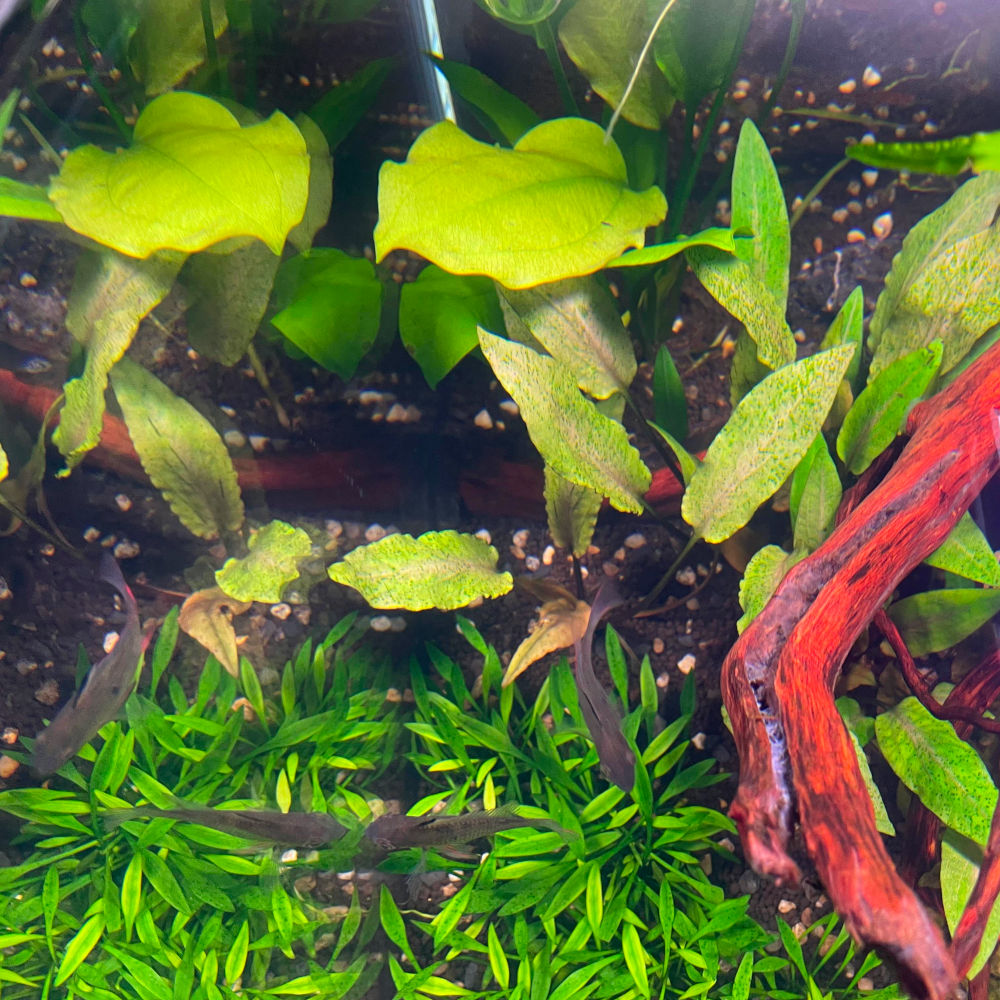
These look like minuscule green hard spots on aquarium walls and plants with slow growth.
Cause(s)
Low nitrate, phosphate imbalance or excess light.
Removal Process(es)
Based on the material of your aquarium, you can use a glass/acrylic-safe algae scraper to clean algae from the aquarium walls. Opt for one with a blade attachment.
Another option is a cleanup crew of nerite snails. While they love eating GSA, they may lay small, unappealing sesame seed-like eggs throughout your aquarium. But they won’t reproduce.
2. Blanket Weed
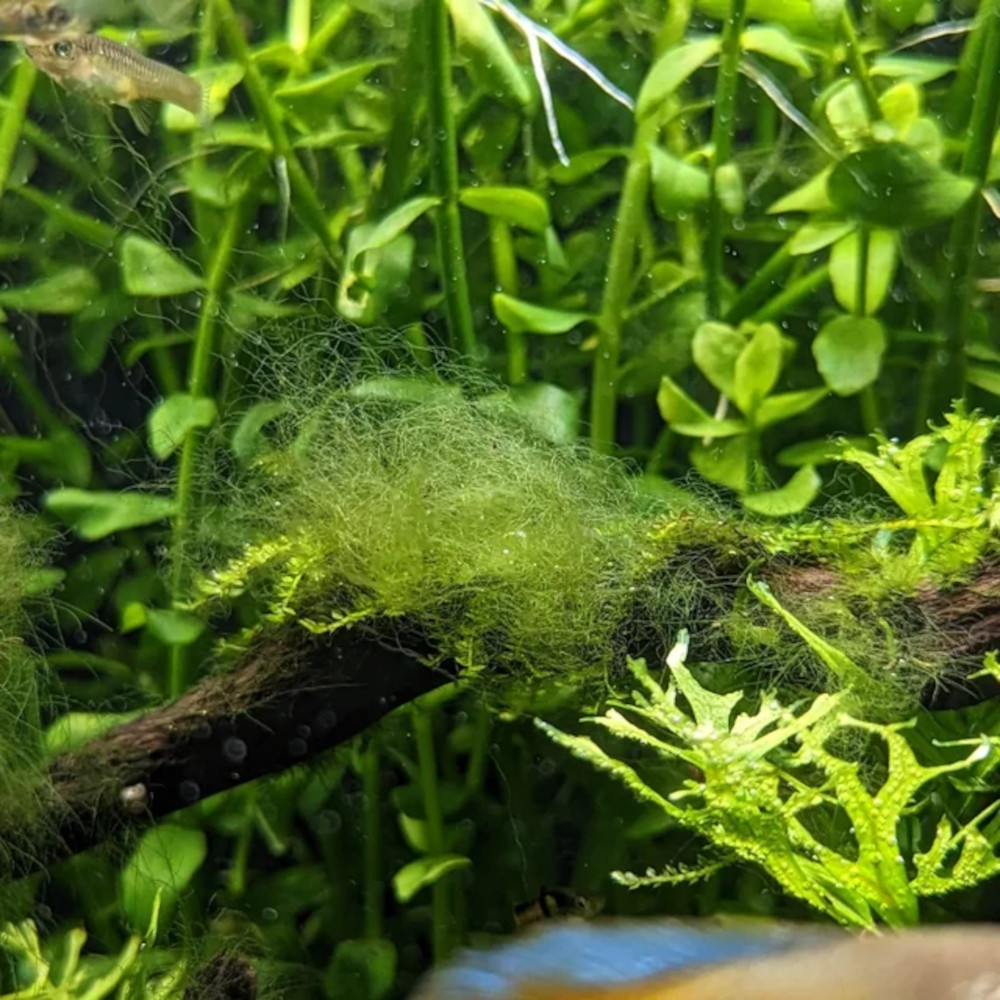
The algae form a stubborn, thick green wool-like coat on plants, hard surfaces, and substrate. It gives a pungent smell if rubbed or crushed.
Cause(s)
Usually introduced into tanks through a light covering on live plants and Marimo moss balls. It grows pretty fast with excess light, nitrates, and CO2 levels.
Removal Process(es)
Switch off the current maker in your tank. This prevents the algae from breaking, spreading, and establishing in other areas.
Manually take out large chunks and use a gravel vacuum to suck out smaller pieces. Spot-treat the algae with Seachem Excel in a syringe for a few weeks. Introduce a cleaning crew of amano shrimps.
For prevention, always quarantine new plants for a few weeks.
3. Fuzz/Green Fuzz Algae

Fuzz algae form a green, short, and fuzzy layer and are mainly seen on tank decor, plants, and tank surfaces. Some wonder whether they’re an early growth stage of some sort of hair algae.
Cause(s)
Excess light and nutrient issues
Removal Process(es)
If you don’t have plants, black out the tank for a few days and reduce the lighting time thereafter.
Invest in a cleanup crew of amano shrimps, black mollies, otocinclus, bristlenose plecos, and American flagfish.
4. Green Dust Algae (GDA)
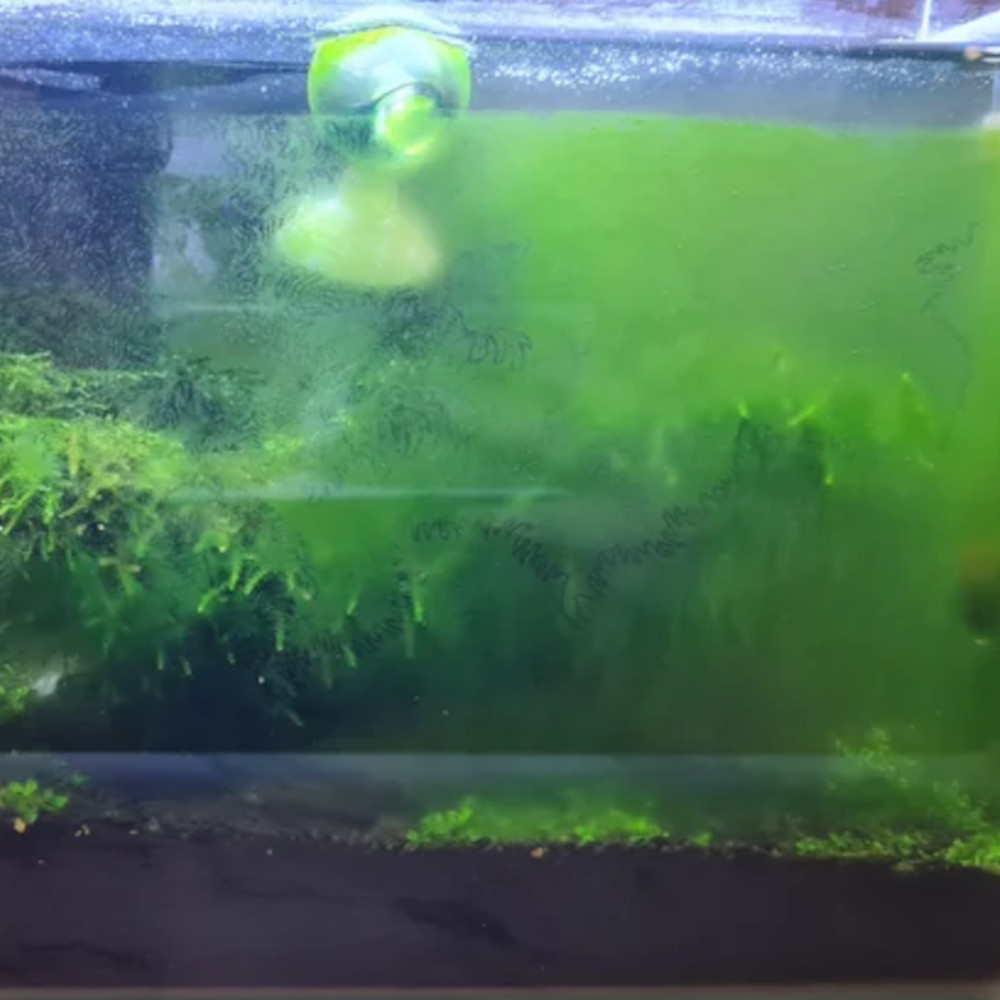
GDA forms irregular, fine, slimy patches on the aquarium surface. Often confused with GSA visually, they’re much softer to touch than the hard and coarse GDA.
Cause(s)
Excess lighting, high nutrients.
Removal Process(es)
Control the lighting hours with a timer. Manually remove most of it by scraping the tank surface and decor before weekly water changes.
5. Staghorn Algae
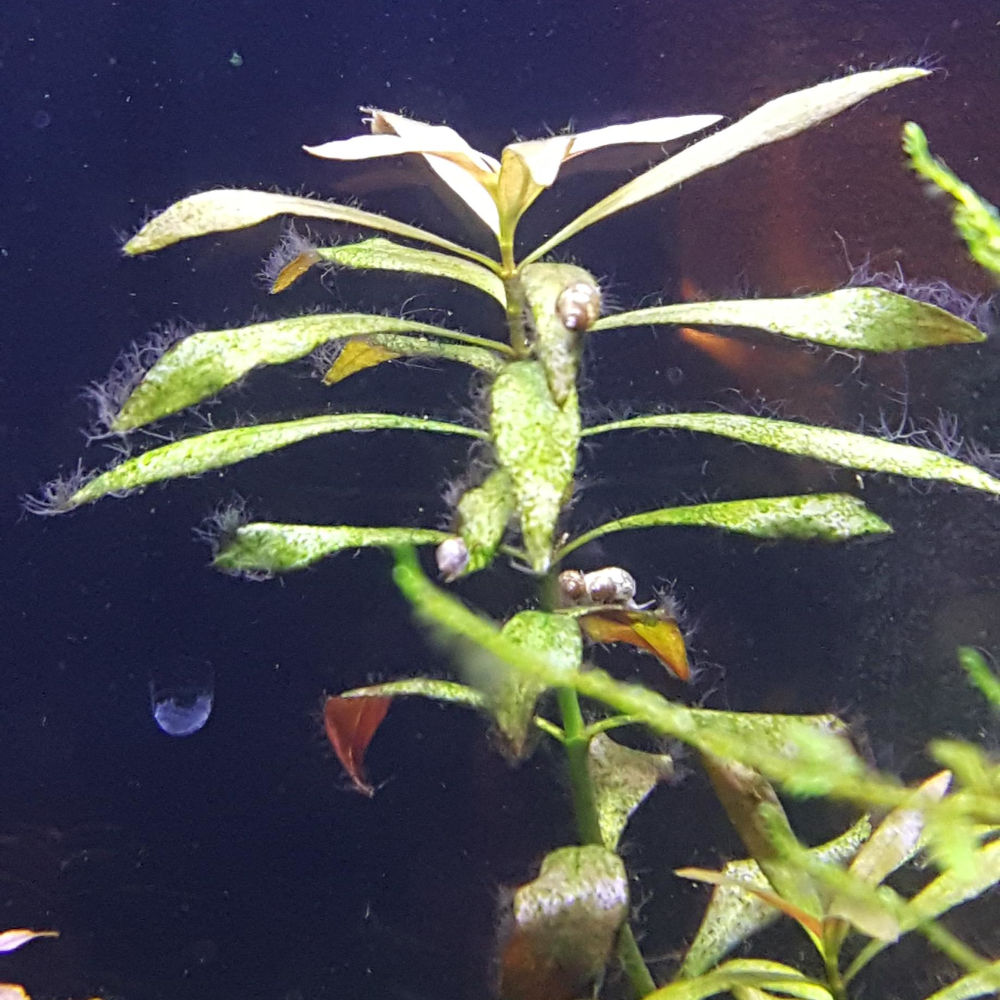
It’s a type of red algae that looks like stag antlers and is usually spotted on decor, equipment, or plant leaf edges.
Cause(s)
Excess light, poor water circulation, and low carbon dioxide.
Removal Process(es)
It’s hard to remove it manually. You can instead add amano shrimps so that they eat it.
You can also spike the CO2 levels and improve water flow throughout the tank. This improves plant growth and further helps them outcompete and starve the algae.
Or turn off water circulation temporarily and directly apply Seachem Excel with a dropper on the algae. After a few rounds of application, they’ll die out.
6. Water Silk

The fast-growing algae are extremely long and strong green threads that are smooth to the touch. Under the microscope, they show a green spiral across the length.
Cause(s)
High ammonia levels due to rotting fish, leftover food, bad tank environment, or released from disturbed substrate. Thrives in high nutrient and CO2 levels and ample lighting.
Removal Process(es)
Conduct a blackout for 3 days with liquid carbon cure and turn the CO2 off. Manually remove as much as possible and introduce algae eaters.
You can also try out hydrogen peroxide cures.
How to Get Rid of Saltwater Algae?
If you have a saltwater tank, the abovementioned algae won’t concern you. Instead, you need to be wary of the following kinds. C’mon, let’s know how to deal with those here…
7. Green Beard Algae

They look just like green fuzz algae but much denser and longer.
Cause(s)
Long lighting hours, low CO2 levels, low nitrates
Removal Process(es)
Treat with hydrogen peroxide solution or liquid carbon (e.g.: Seachem Flourish Excel).
8. Red Slime
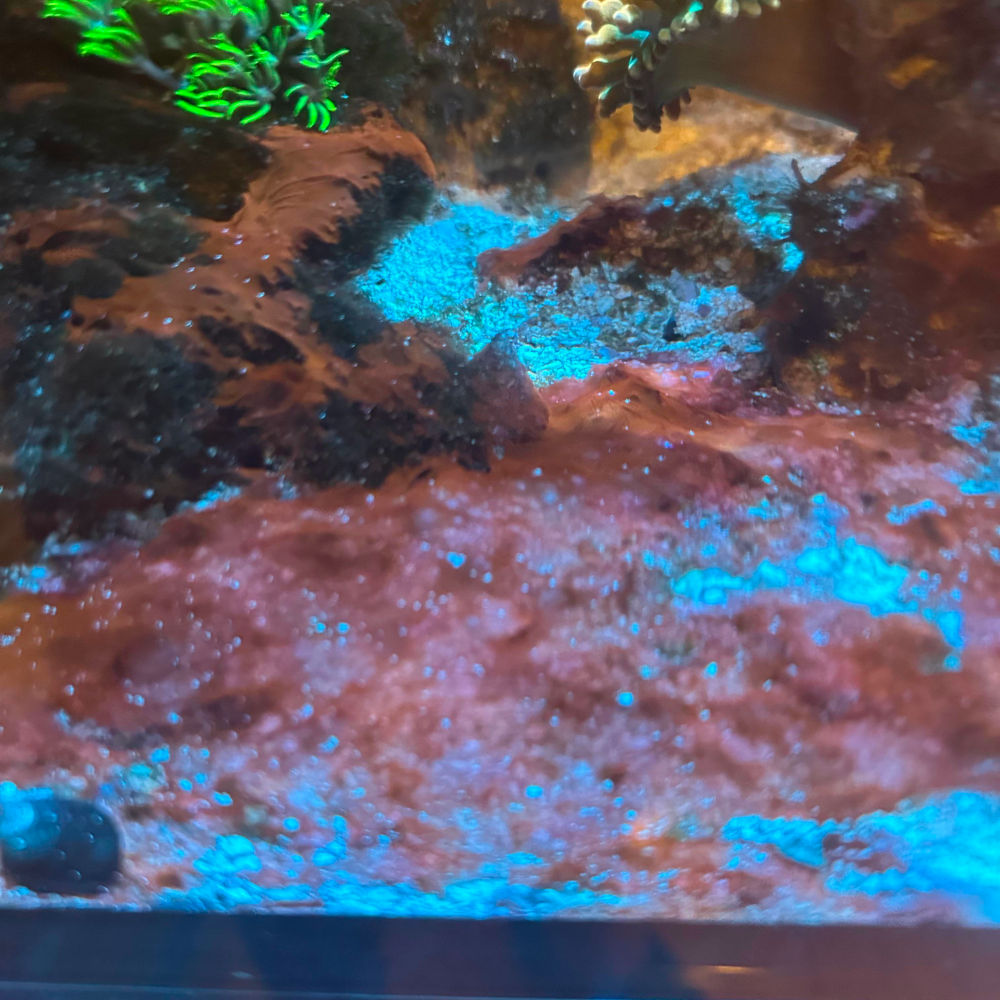
Red slime algae are cyanobacteria, not true algae. They are reddish-brown, yellowish-orange, deep purple, to even black.
Cause(s)
Red-slime-contaminated water source, high phosphate and iron levels, low flow regions, warmer water, low alkalinity of water.
Removal Process(es)
Scrape your tank surface with magnesium scrapers. For corals and rocks, lightly scrape with a toothbrush. It forms a mat-like layer on the substrate; pull it off yourself.
Perform 30% weekly water changes using RO/DI water. Get rid of all rotting organic matter.
To reduce phosphate levels, use granulated ferric oxide or a phosBan reactor. Opt for low phosphate content food.
9. Green Turf Algae
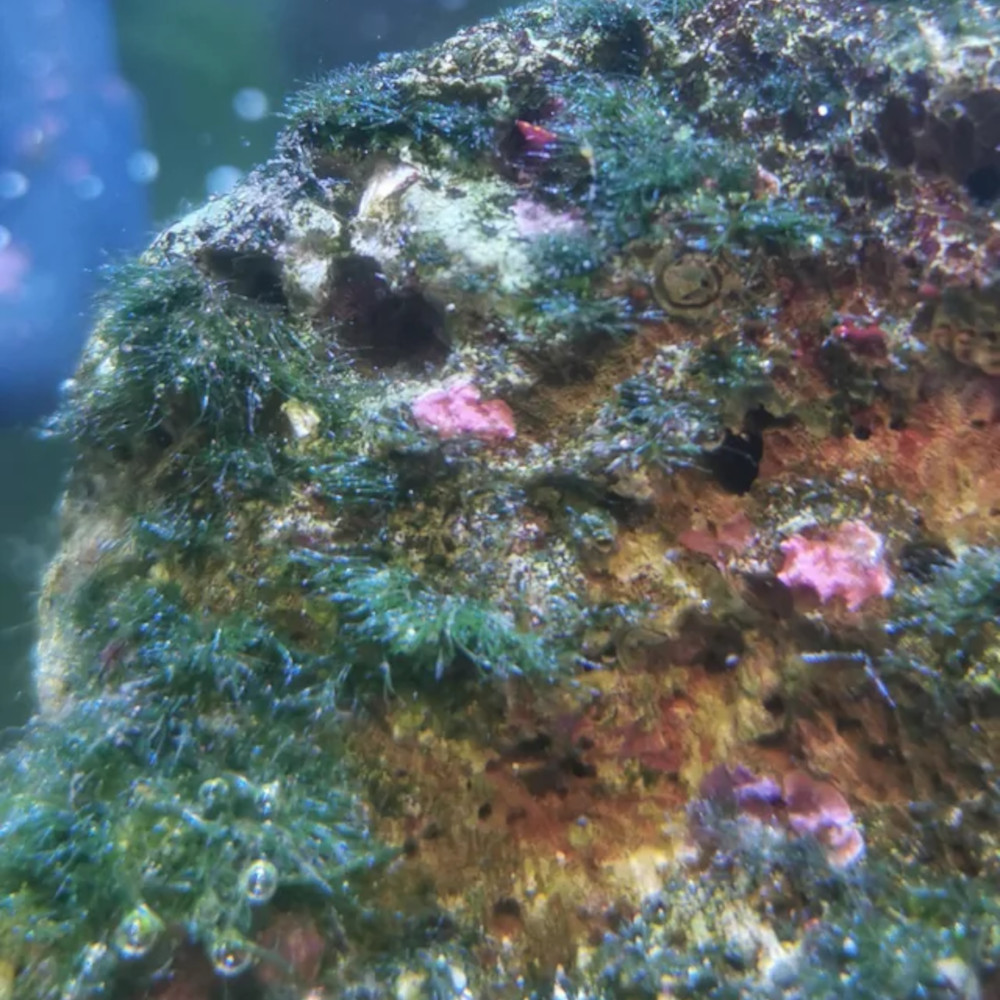
These refer to a large variety of coarse macroalgae, which have thicker and wider blades than hair algae. They usually don’t have mat-like roots and even appear on rocks.
Cause(s)
Excess nutrients and leftover food.
Removal Process(es)
If it grows on rocks, it’s hard to remove. Dip the rock in algaecide for quick results. If the algae grow roots, let it grow bigger, and it can be easily peeled or scraped by rubbing. Use cleaning crews of urchins, emerald crabs, and chitons.
10. Bryopsis pennata and Bryopsis plumosa

These fast-growing algae types have branched structures like leaves with a strong and wide midrib. B. pennata has more spare and irregular branching than B. plumosa which has a fuller and symmetrical branching.
Cause(s)
Introduced through live rock, coral frag, or even some unknown Cause(s).
Removal Process(es)
Let algae eaters like pitho crabs, urchins, sea hares, emerald crabs, nudibranchs, and chitons take control of the situation.
It’s harder to remove if they grow from mats instead of a single decor or object. If any piece of algae remains, it’ll grow back.
11. Bubble and Red Bubble Algae (Valonia and Red Valonia)
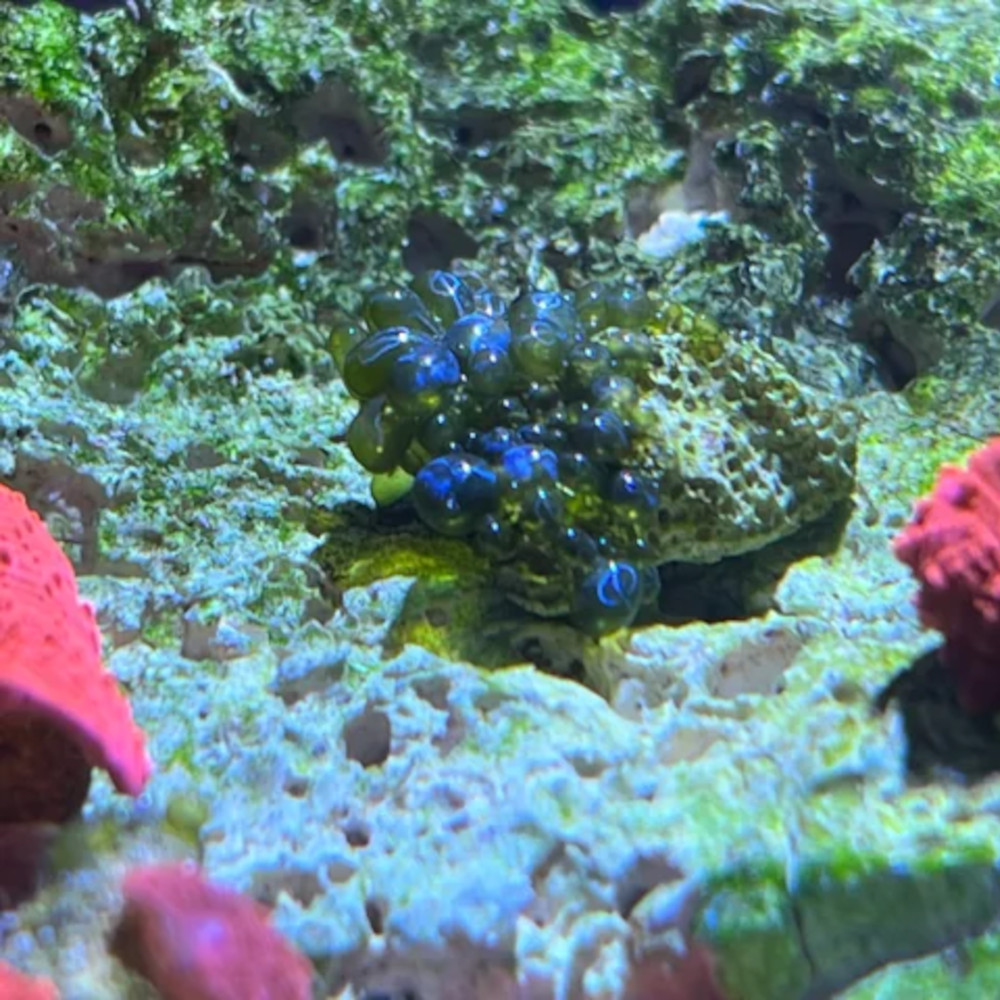
Valonia look like green spherical or elongated bubbles that reproduce by bursting and releasing spores. Thus, it can invade your tank pretty quickly. Invasive red valonia are red in color and grow from rocks.
Cause(s)
Introduced via spores on live rock and coral frag plugs
Removal Process(es)
If it’s on a rock, cover and aggressively scrape it with a baster. Rinse and repeat for each rock. Introduce a cleanup crew of emerald and ruby mithrax crabs and pitho crabs. Prevent it by inspecting and quarantining all new rocks and frags.
12. Lobophora
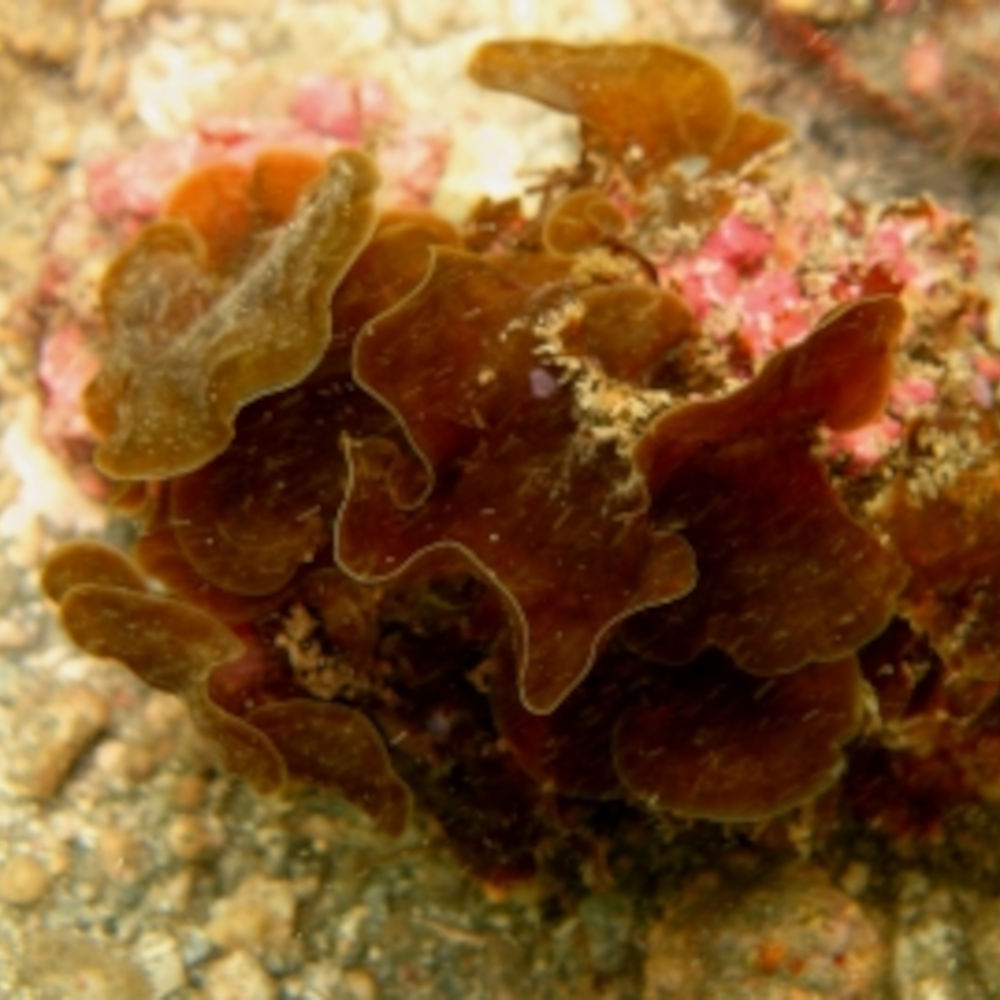
The macroalgae is brown-red and yellow, semi-hard, slippery, and rubbery. It can take a ruffled ribbon form or saucer shape.
Cause(s)
Introduced through decor like shells, corals, and rocks.
Removal Process(es)
Using a flexible or chisel knife, cut the algae out along with a thin layer of the decor itself to ensure there’s none remaining. Get a cleaning crew of emerald crabs, tangs, urchins, chitons, and limpets.
13. Red Algae (e.g.: Gelidium or Red Wiry/Turf Algae, Cotton Candy Algae, Chondria)
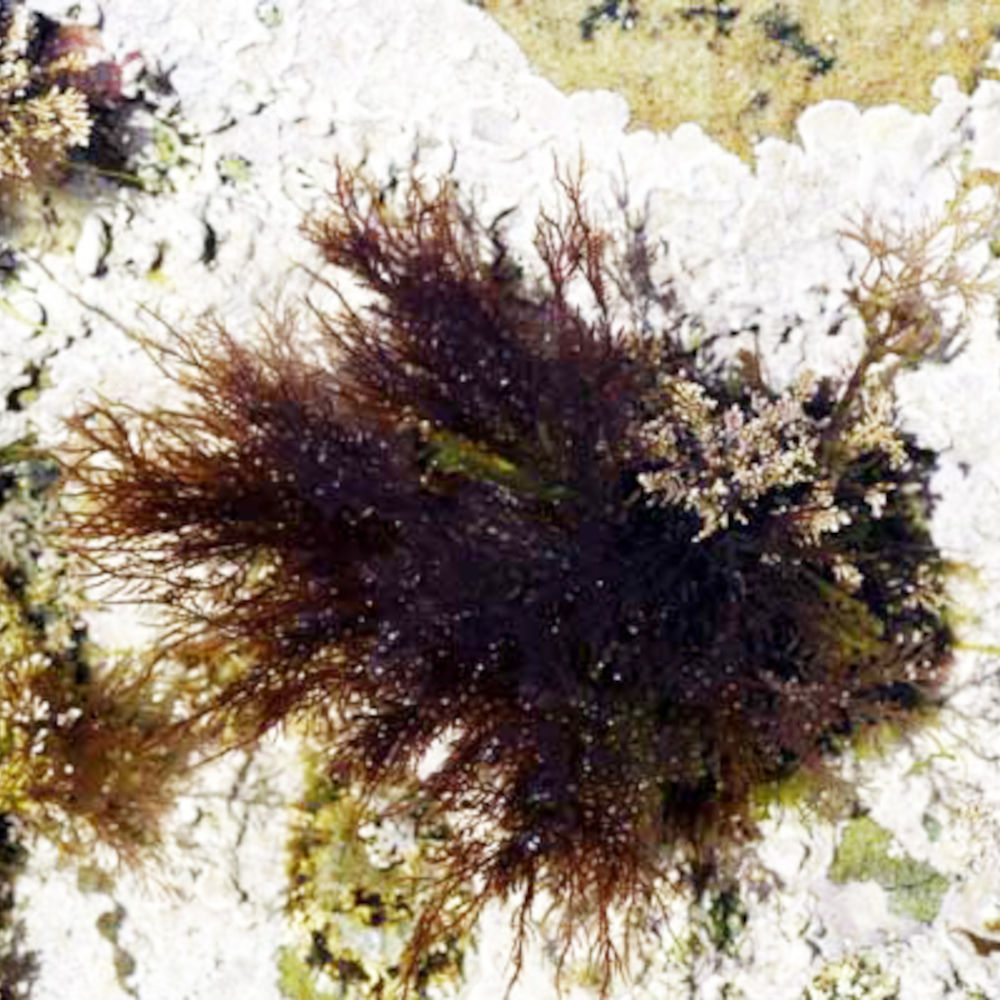
Geledium is a genus of all sorts of short red algae that have a wiry look and are extremely difficult to remove.
Cotton candy algae are a red algae type with light pink, fuzzy branches and branchlets. It can also seem dirty brown or red. Though a rare occurrence, it overpowers your tank fast.
Chondria are translucent, cylindrical red algae with irregular branches.
Cause(s)
High nutrients (nitrates and phosphates), long lighting in the tank
Removal Process(es)
You can take out the objects they grow on and manually remove them using tweezers or dental picks. Scrub and wash well to leave no pieces. Or, add a cleanup crew of emerald crabs, sea hares, urchins, and large turbos.
14. Green Wiry Algae

The Cladophoropsis genus of green algae has a wiry form and clings to liverocks and frags. It has short branches and spreads from runners.
Cause(s)
Poor water flow, rotting material, overcrowded areas, and dark spots in usually brightly lit tanks.
Removal Process(es)
Manually remove with dental picks. Use a cleaning crew of emerald crabs, rock-boring urchins, sea hares, and turbos.
15. Dictyota

The brown algae species has an iridescent blue sheen and non-rigid forked branches. They grow from rocks and lack trunk-like features.
Cause(s)
Excess nutrients.
Removal Process(es)
Quarantine all live rocks, scrape infected objects aggressively, or starve off nutrients using chaetomorpha macroalgae. Or let emerald crabs, sea hares, chitons, tangs, and urchins eat it.
16. Sea Grapes

The algae look like green grapes growing from a runner or root system.
Cause(s)
Excess phosphates
Removal Process(es)
You may use dental picks to remove them. Let emerald crabs, tangs, angels, urchins, sea hares, and limpets eat them. Or, use a phosBan reactor or macroalgae like chaeto to cut down phosphate levels.
How to Get Rid of Algae Common to All Environments?
There are many sorts of algae strains that invade freshwater, saltwater, and brackish water environments. So, let’s read about them here:
17. Brown Diatom Algae
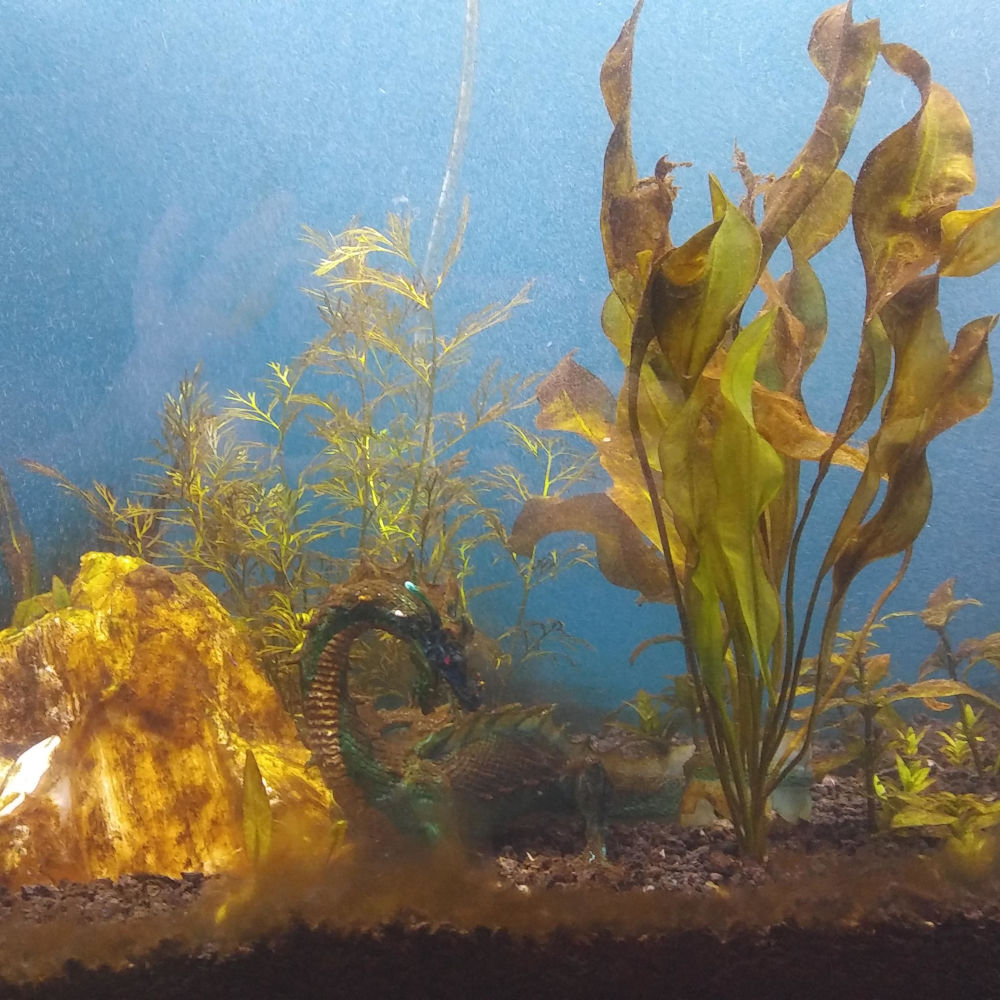
Brown diatom seems like brown or yellowish green dusty or stringy matter on your aquarium walls, decor, and substrate.
Cause(s)
It appears in newly planted tanks due to high silicates and phosphates.
Removal Process(es)
It’s soft and can be easily cleared with an algae-scrubbing sponge. If you let it be, the plants will eventually absorb all excess silicates and phosphates and starve off the algae.
Cleanup crew like shrimps, otocinclus catfish, and snails also feed on it.
18. Black Beard Algae (BBA)
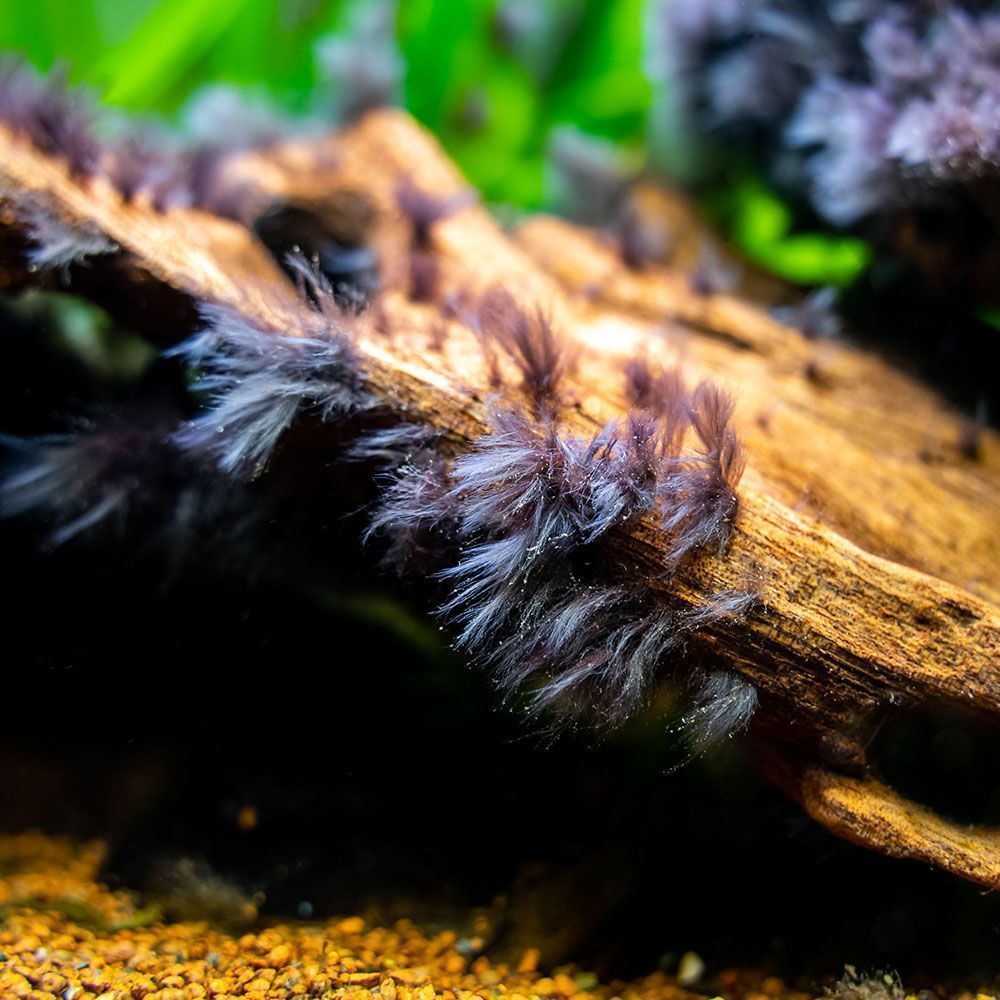
BBA appears in bushy, dense black, grey, reddish, or brownish clumps. It’s usually spotted on aquarium decor, plants, and driftwood. If not treated, it only takes 1-2 years to overpower aquariums completely.
Cause(s)
It appears due to several reasons, like poor maintenance, poor water quality, fertilizer overdosage, CO2 level fluctuations, excess light, or a combination of all.
Removal Process(es)
You can use a cleanup crew of Siamese algae eaters, Florida flagfish, or a bunch of amano shrimp.
If the algae are robust, directly spray liquid carbon. For mild cases, dose the specific water column. But be cautious and don’t apply it on sensitive plants like Vallisneria.
If the algae infest your plants, take it out and spray 3% hydrogen peroxide. Let it be for 5 minutes, rinse it, and put it back in the aquarium.
Dying BBA seems red or clear and that’s when your aquatic inhabitants will also start eating them.
BBA is established in aquariums within 6-8 weeks and takes as long to be eliminated.
19. Hair/Thread Algae
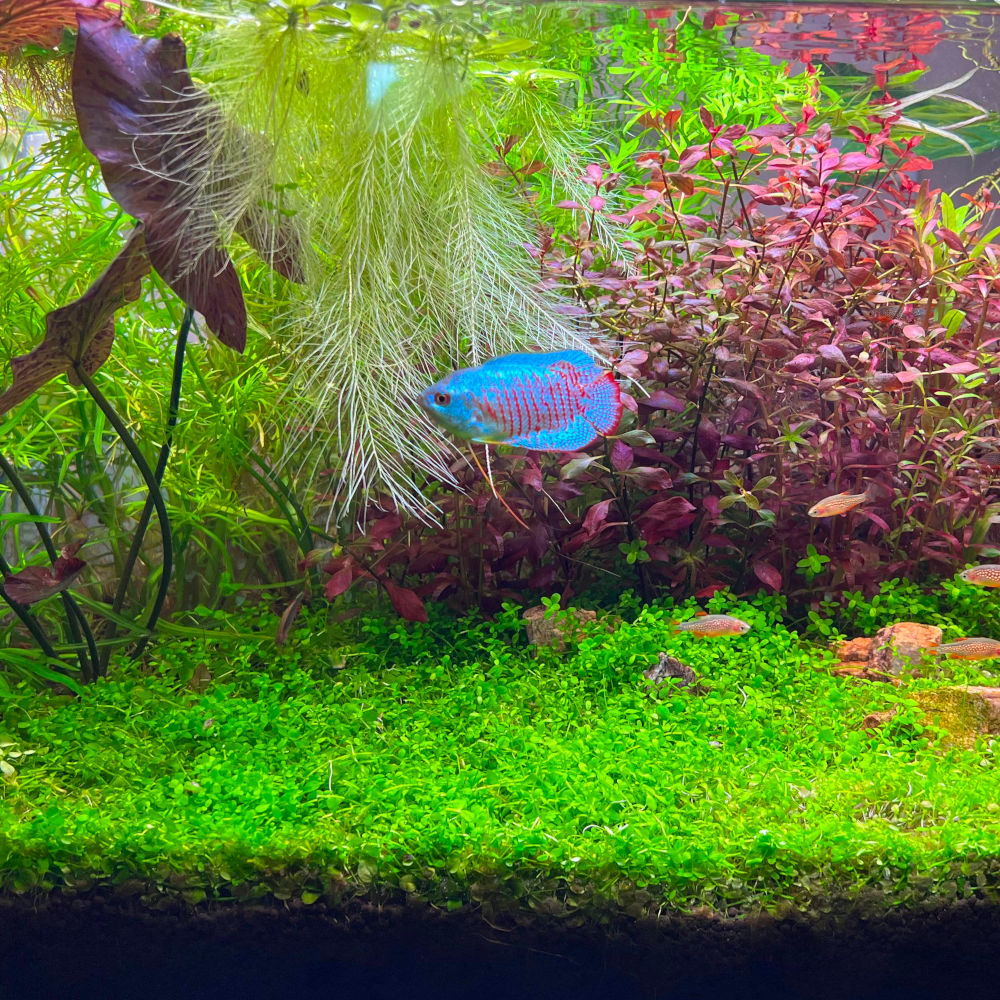
This houses all the algae types that look similar to wet hair when taken out of the aquarium, including (hair algae, thread algae, and string algae).
Cause(s)
Excess iron, excess light, or a combination of low nutrients and long periods of lighting.
Removal Process(es)
A few ways to get rid of the rapid-growing stubborn algae are to keep the lights on for shorter time spans, add more fertilizer, or reduce iron levels.
Or, use a cleanup crew of amano shrimp, Siamese algae eaters, Florida flagfish, or molly fish. You can also manually remove the clumpy algae with a toothbrush.
20. Blue-Green Algae (BGA)
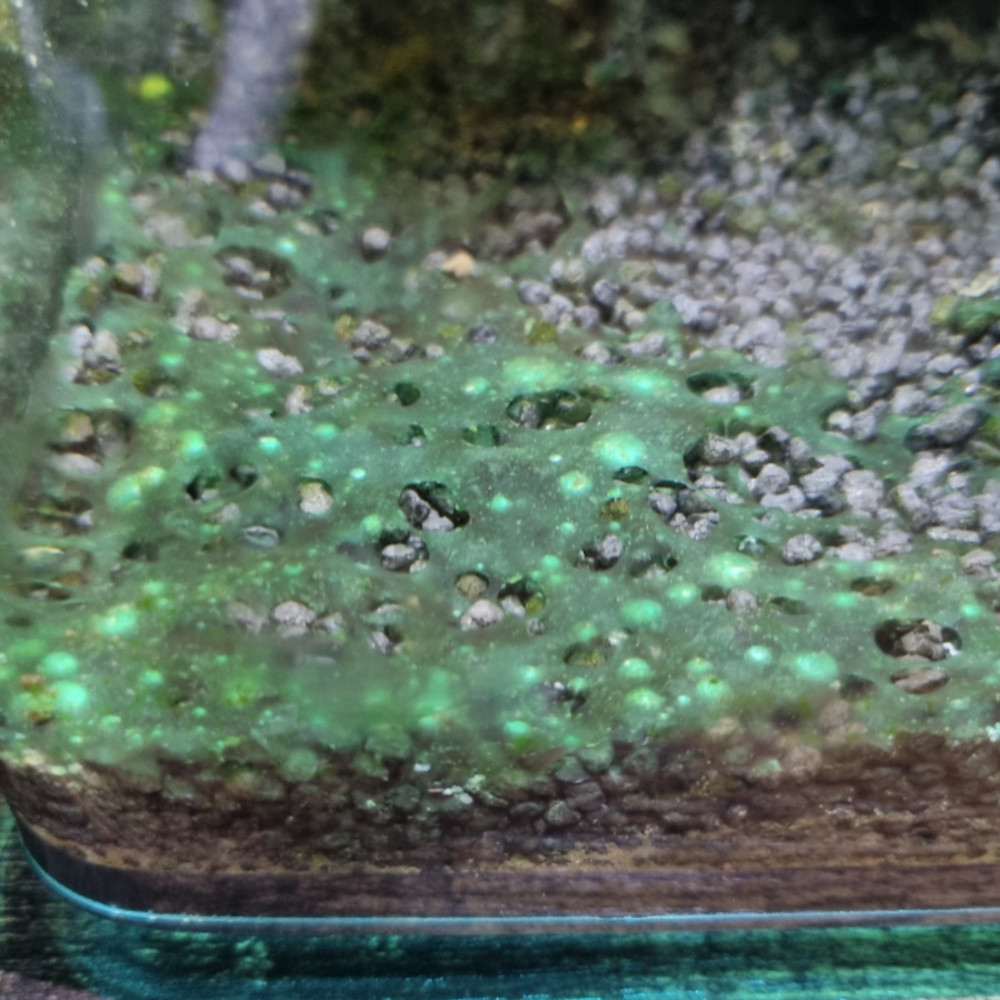
BGA is actually a bacteria with traits of plants – aka cyanobacteria. It forms a slimy coat on decor, plants, and substrate and has a distinct smell.
Cause(s)
Unknown
Removal Process(es)
The most useful tips include better aquarium maintenance or better water circulation with a powerhead or airstone.
Since it needs photosynthesis to survive, some even recommend blackouting for one week. But avoid it if you have plants.
Other options are manual removal by hand, water changes, and vacuuming the substrate. Another option is using antibiotics and stopping water change for a week. Repeat the treatment if things don’t look too well.
Cleanup crews aren’t much help.
21. Green Water Forming Algae
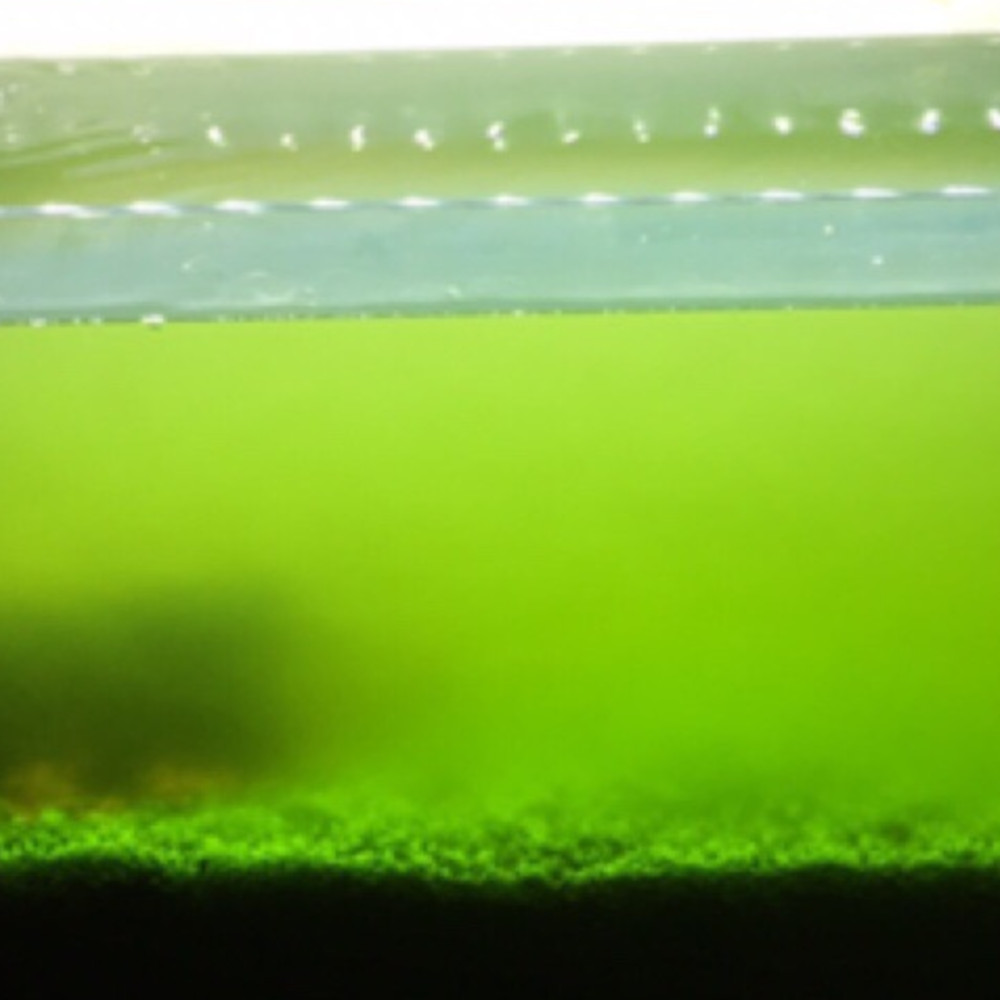
In this case, your entire aquarium water looks like green pea soup due to the uncontrollable multiplication of freely floating single-celled phytoplankton.
Cause(s)
Excess lighting, especially from direct sunlight, excess ammonia (common in new uncycled tanks or overfeeding), or double-dosed fertilizers.
Removal Process(es)
Large water changes aren’t much help. Black out the entire tank for a week if you don’t have plants. Or, use a UV sterilizer to kill all the algae within 3 days.
22. Rhizoclonium Algae

The algae seem like brown or green sticky strands, much like hair algae.
Cause(s)
Poorly maintained aquarium with low water circulation, low oxygen levels, and low nutrition.
Removal Process(es)
Check tank nutritional levels and adjust accordingly. Clean your aquarium and maintain it properly to prevent it. Raise oxygen levels and water flow. Introduce amano shrimp in the tank.
23. White Algae

It’s a single-celled creature that has a web-like shiny top layer. White algae grow on driftwood, pebbles, decor, or aquarium surface.
Cause(s)
Poor filtration and excess light.
Removal Process(es)
Perform multiple water changes but stay within a limit to avoid stressing tank inhabitants. Introduce any kind of algae-eater fish or invertebrates. Check and maintain nutrient levels. Use lights with timers.
24. Film/Green Film Algae
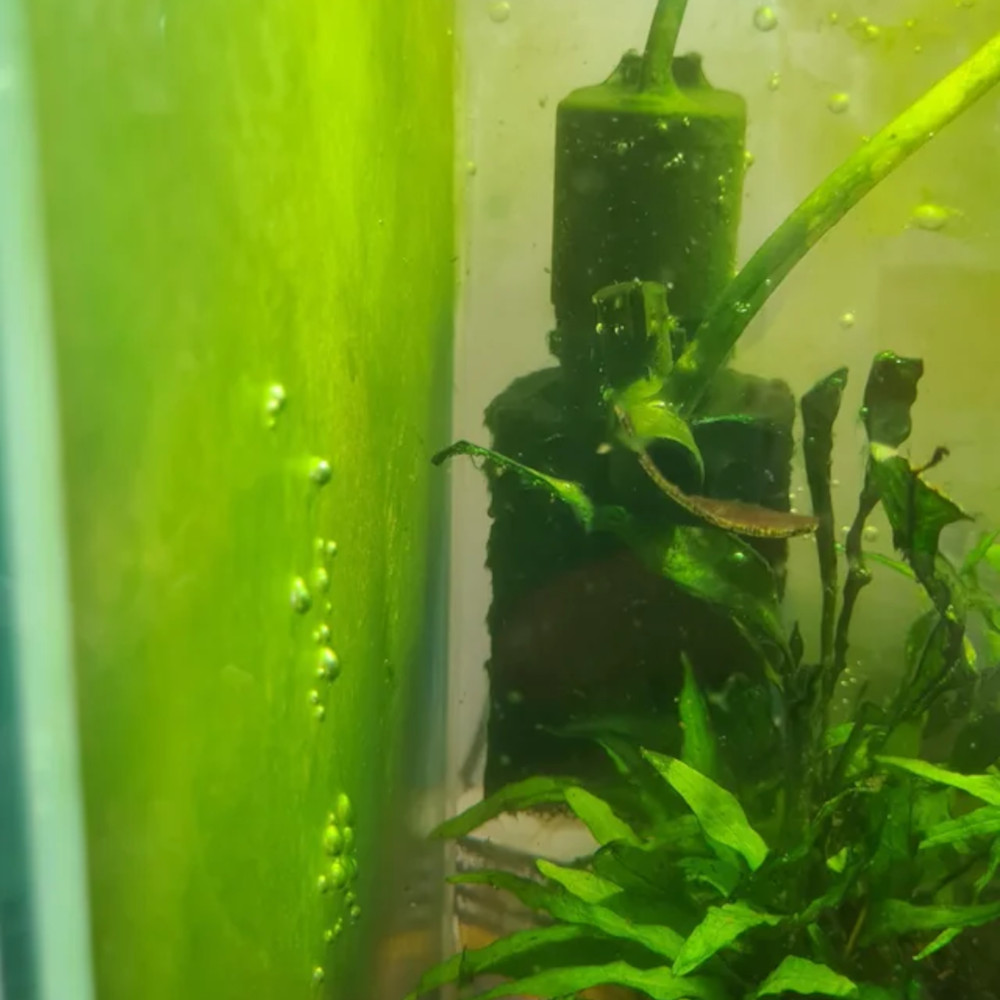
Film algae appear as a powdery green film or cause cloudiness in the water.
Cause(s)
It usually occurs slightly, in all tanks, at all times. But becomes dense once there’s an algal bloom due to high lighting period, intense LED lights, and a nutrient-rich environment.
Removal Process(es)
Use magnesium scrapers like MagFloat on aquarium walls and toothbrush on rocks to manually remove it. Stir the sediments at the bottom and perform water changes.
Invest in cleaners like cerith, nerite, and astraea turbo snails, chitons, limpets, and various species of copepods, isopods, and amphipods.
With a phosBan reactor or granulated ferric oxide, remove excess phosphates to starve the algae.
25. Dinoflagellates
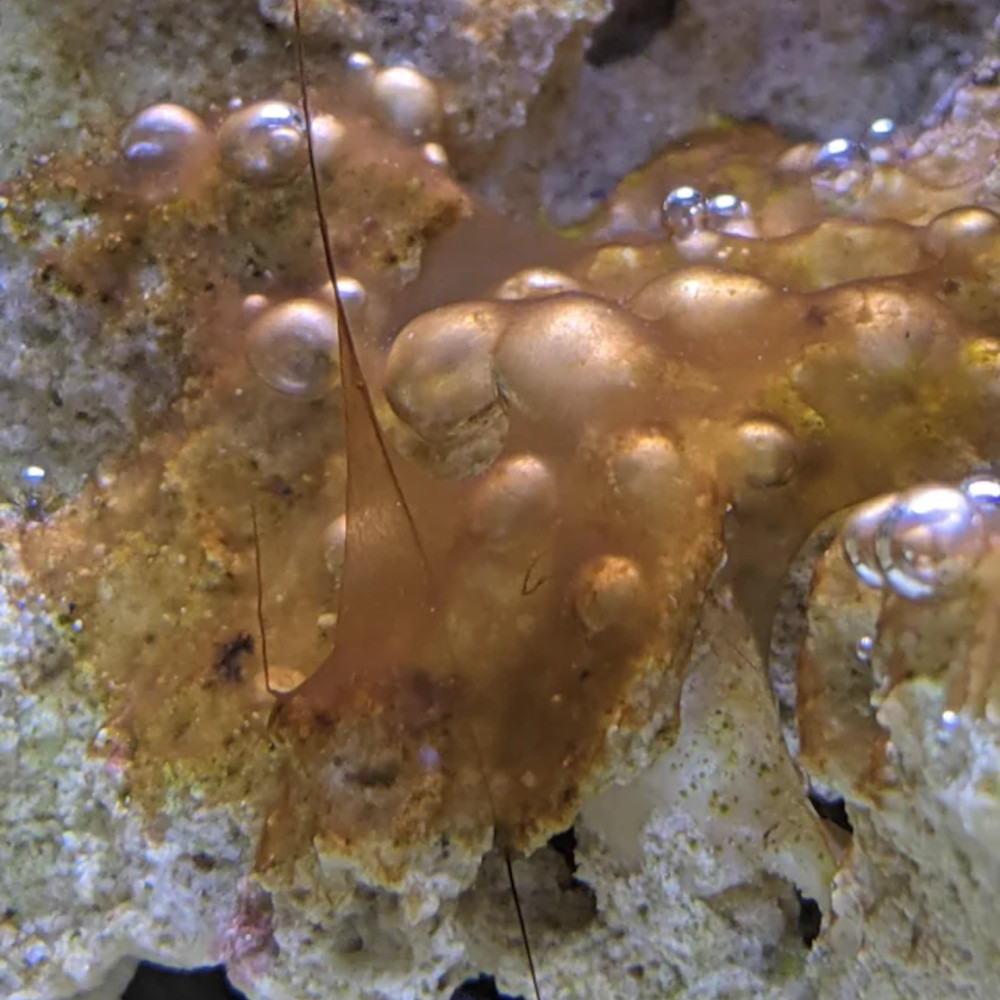
The light brown snot-like algae grow from sand and rock and have trapped air bubbles in between.
Cause(s)
Extremely high nutrient levels.
Removal Process(es)
Take out the object it grew on, completely immerse it in a container with water, boil, scrub, and rinse several times. Let it dry under the sun for a few days.
Or, skim the algae and use a phosBan reactor or chaeto macroalgae to starve it.
A word from FishInAquarium
Algae is an obvious part of every aquatic ecosystem. So, take small steps to test your water for possible Cause(s), and don’t feel frustrated.
Be patient, and don’t go overboard with the chemical treatments. Otherwise, you may harm the ecosystem instead.
With that said, if you’re satisfied with this guide, help fellow aquarists deal with algal attacks in their tanks. And if you have any questions, drop us an email, and we’ll reach out with solutions!

